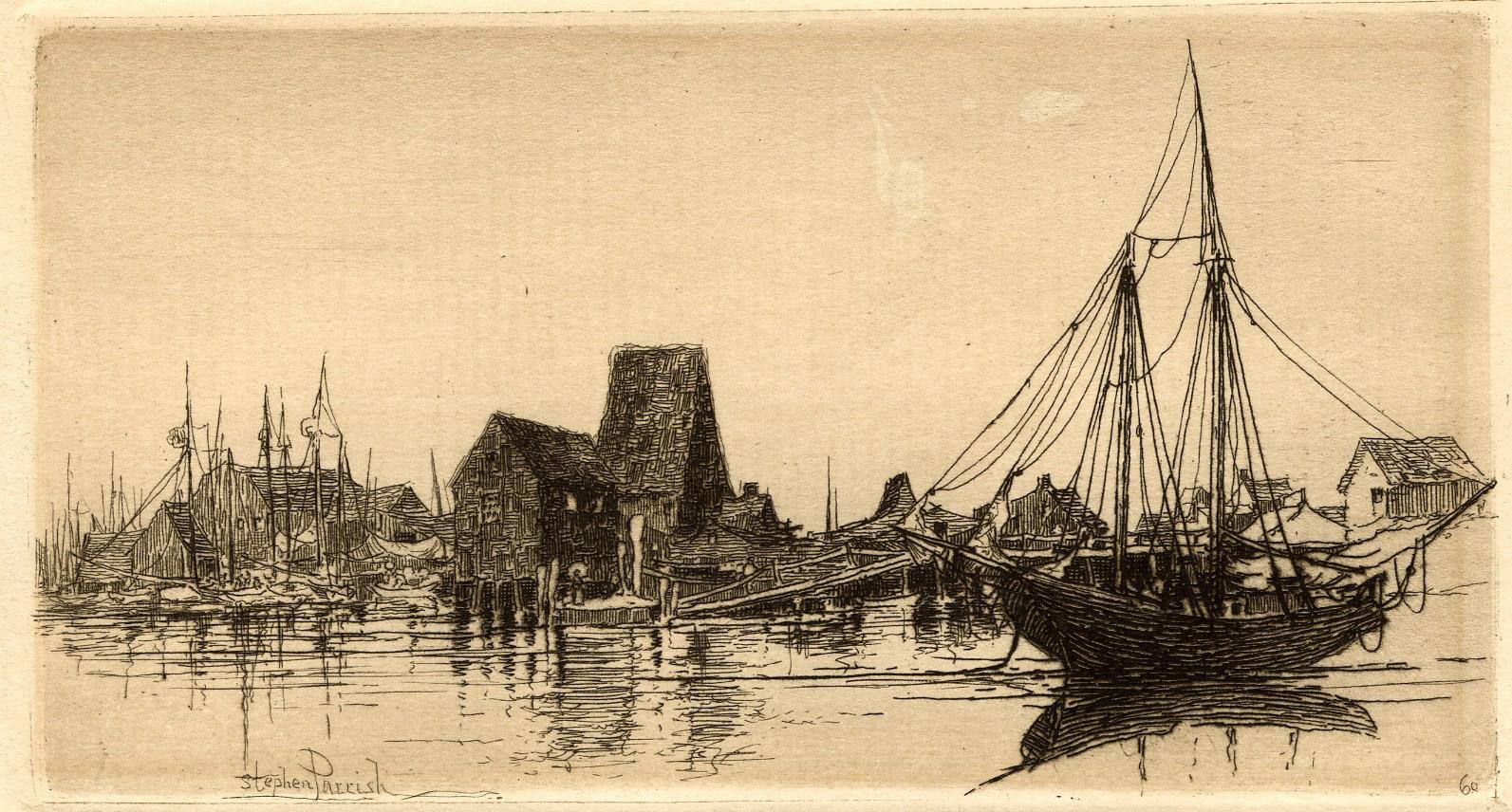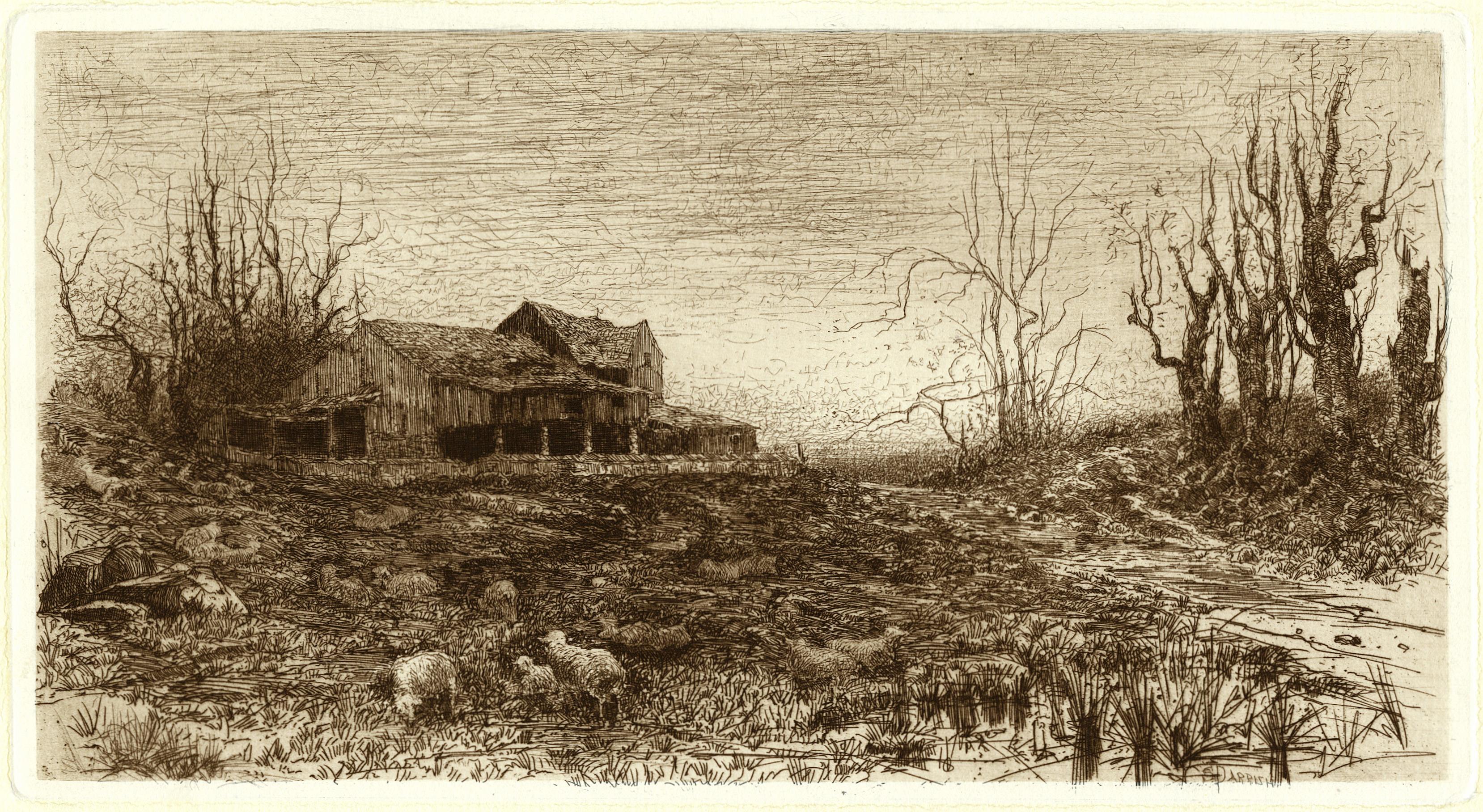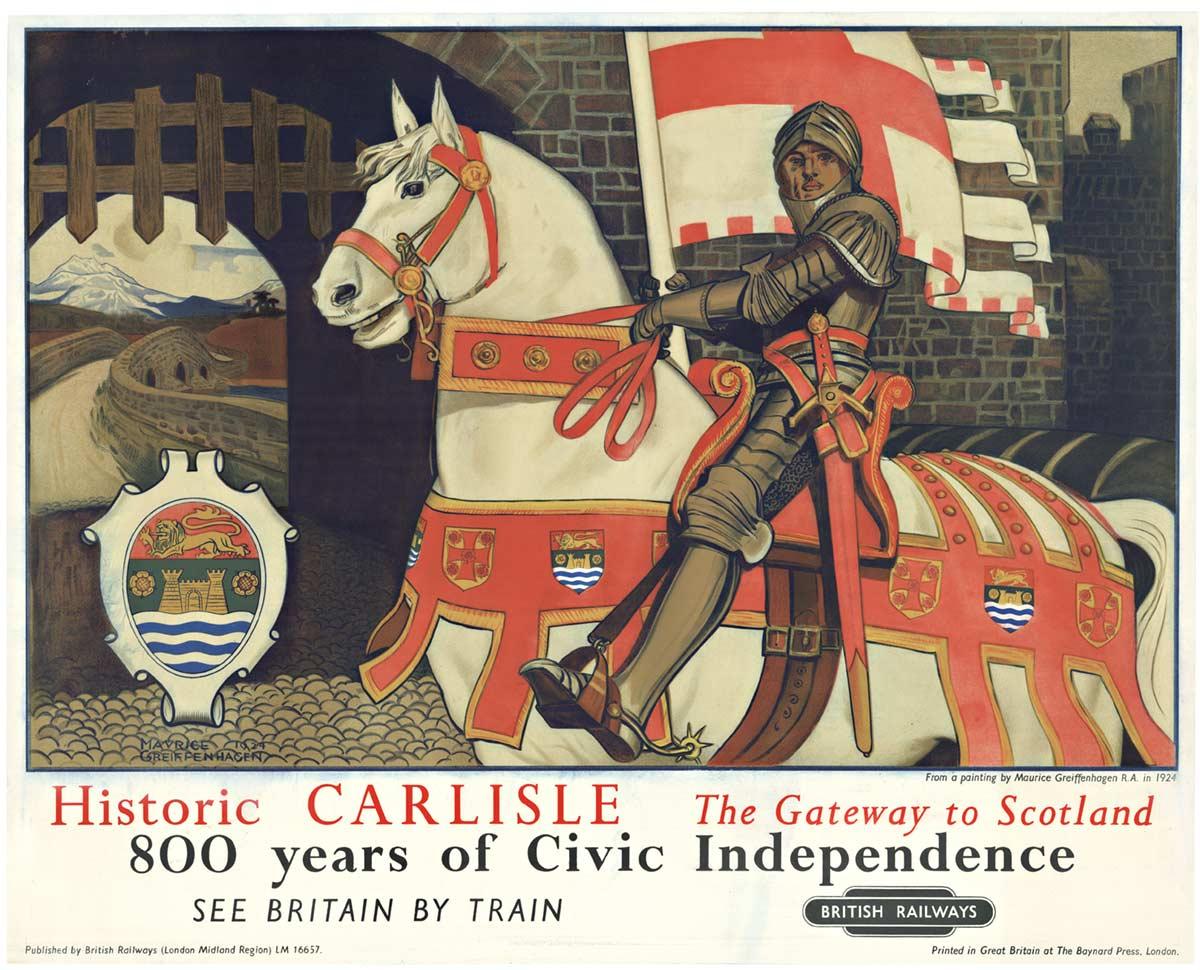Items Similar to Bridges of Florence
Want more images or videos?
Request additional images or videos from the seller
1 of 6
Alonzo C. WebbBridges of Florence1929
1929
About the Item
Alonzo C. Webb, 'Bridges of Florence', etching, 1929, edition 100. Signed and titled in pencil. Signed and dated in the plate, lower left. A superb, richly-inked impression, in warm black ink, on cream wove paper, with full margins (2 to 3 1/2 inches), in excellent condition. Image size 10 3/8 x 13 1/8 inches (264 x 333 mm); sheet size 15 x 19 7/8 inches (381 x 505 mm). Archivally matted to museum standards, unframed.
Ex-collection Kennedy Galleries, New York.
ABOUT THE ARTIST
Alonzo C. Webb (1888-1975) was an esteemed American etcher, architect, painter, and illustrator. Webb studied art at the Art Institute of Chicago and the Art Students League of New York. In the First World War, he served with the American Engineering Force in France, first as a sergeant and then as a commissioned second lieutenant. After the war, in 1918, he concluded his education at the American Expeditionary Forces Art Training Center in Bellevue, France.
During the 1920s and 1930s, Webb lived and worked in Paris and the United States. He produced an extensive oeuvre of beautifully rendered images of historic French and Italian architecture and views of American cities, including New York, Chicago, and Pittsburgh. Many of Webb's European works were published and exhibited by the Marcel Guiot Gallery, Paris.
Webb was a member of the American Art Association of Paris and the Beaux-Arts Architects. His etchings are included in the collections of The Art Institute of Chicago; Five Colleges and Historic Deerfield Museum Consortium, National Gallery of Art, New York Public Library, San Diego Museum of Art, Smithsonian American Art Museum, Yale University Art Gallery, and in the collections of the Government of France; the City of Paris, and the Bibliotheque Nationale (Paris).
- Creator:Alonzo C. Webb (1888 - 1975, American)
- Creation Year:1929
- Dimensions:Height: 10.38 in (26.37 cm)Width: 13.13 in (33.36 cm)
- Medium:
- Movement & Style:
- Period:
- Condition:
- Gallery Location:Myrtle Beach, SC
- Reference Number:
About the Seller
5.0
Recognized Seller
These prestigious sellers are industry leaders and represent the highest echelon for item quality and design.
Platinum Seller
These expertly vetted sellers are 1stDibs' most experienced sellers and are rated highest by our customers.
Established in 1995
1stDibs seller since 2016
254 sales on 1stDibs
Typical response time: 1 hour
Associations
International Fine Print Dealers Association
- ShippingRetrieving quote...Ships From: Myrtle Beach, SC
- Return PolicyA return for this item may be initiated within 7 days of delivery.
More From This SellerView All
- 'Threshing' — 1940s American RegionalismBy Thomas Hart BentonLocated in Myrtle Beach, SCThomas Hart Benton, 'Threshing', lithograph, 1941, edition 250, Fath 48. Signed in pencil. Signed in the stone, lower left. A fine, richly-inked impression, on off-white, wove paper, with full margins (1 3/8 to 1 5/8 inches), in excellent condition. Published by Associated American Artists. Image size 9 5/16 x 13 13/16 inches (237 x 351 mm); sheet size 12 1/2 x 16 5/8 inches (318 x 422 mm). Archivally matted to museum standards, unframed. Impressions of this work are held in the following museum collections: Art Institute of Chicago, Fine Arts Museums of San Francisco, High Museum of Art, McNay Art Museum, Montgomery Museum of Fine Arts, and Nelson-Atkins Museum of Art. ABOUT THE ARTIST “Benton’s idiom was essentially political and rhetorical, the painterly equivalent of the country stump speeches that were a Benton family tradition. The artist vividly recalled accompanying his father, Maecenas E. Benton — a four-term U.S. congressman, on campaigns through rural Missouri. Young Tom Benton grew up with an instinct for constituencies that led him to assess art on the basis of its audience appeal. His own art, after the experiments with abstraction, was high-spirited entertainment designed to catch and hold an audience with a political message neatly bracketed between humor and local color.” —Elizabeth Broun “Thomas Hart Benton: A Politician in Art,” Smithsonian Studies in American Art, Spring 1987, p. 61 Born in 1889 in Neosho, Missouri, Benton spent much of his childhood and adolescence in Washington, D.C., where his lawyer father, Maecenas Eason Benton, served as a Democratic member of Congress from 1897 to 1905. Hoping to groom him for a political career, Benton’s father sent him to Western Military Academy. After nearly two years at the academy, Benton convinced his mother to support him through two years at the Art Institute of Chicago, followed by two more years at the Academie Julian in Paris. Benton returned to America in 1912 and moved to New York to pursue his artistic career. One of his first jobs was painting sets for silent movies, which were being produced in Fort Lee, New Jersey. Benton credits this experience with giving him the skills he needed to make his large-scale murals. When World War I broke out, Benton joined the Navy. Stationed in Norfolk, Virginia, he was assigned to create drawings of the camouflaged ships arriving at Norfolk Naval Station. The renderings were used to identify vessels should they be lost in battle. Benton credited being a ‘camofleur’ as having a profound impact on his career. “When I came out of the Navy after the First World War,” he said, “I made up my mind that I wasn’t going to be just a studio painter, a pattern maker in the fashion then dominating the art world–as it still does. I began to think of returning to the painting of subjects, subjects with meanings, which people, in general, might be interested in.” While developing his ‘regionalist’ vision, Benton also taught art, first at a city-supported school and then at The Art Students League (1926–1935). One of his students was a young Jackson Pollock, who looked upon Benton as a mentor and a father figure. In 1930, Benton was commissioned to paint a mural for the New School for Social Research. The ‘America Today’ mural, now on permanent exhibit at the Metropolitan Museum of Art, was followed by many more commissions as Benton’s work gained acclaim. The Regionalist Movement gained popularity during the Great Depression of the 1930s. Painters, including Benton, Grant Wood, and John Steuart Curry, rejected modernist European influences preferring to depict realistic images of small-town and rural life—reassuring images of the American heartland during a period of upheaval. Time Magazine called Benton 'the most virile of U.S. painters of the U.S. Scene,' featuring his self-portrait on the cover of a 1934 issue that included a story about 'The Birth of Regionalism.' In 1935, Benton left New York and moved back to Missouri, where he taught at the Kansas City Art Institute. Benton’s outspoken criticism of modern art, art critics, and political views alienated him from many influencers in political and art scenes. While remaining true to his beliefs, Benton continued to create murals, paintings, and prints of some of the most enduring images of American life. The dramatic and engaging qualities of Benton’s paintings and murals attracted the attention of Hollywood producers. He was hired to create illustrations and posters for films, including his famous lithographs for the film adaptation of John Steinbeck’s ‘Grapes of Wrath’ produced by Twentieth Century Fox. Benton’s work can be found at the Art Institute of Chicago, High Museum of Art, Fine Arts Museums of San Francisco, Library of Congress, McNay Art Museum, Metropolitan Museum of Art, Minneapolis Institute of Arts, Montgomery Museum of Fine Arts, National Gallery of Art, Nelson-Atkins Museum of Art, Smithsonian American Art Museum, Whitney Museum of American Art, The Truman Library and many other museums and galleries across the US. He was elected to the National Academy of Design, has illustrated many books, authored his autobiography, and is the subject of ‘Thomas Hart Benton,’ a documentary by Ken Burns.Category
1940s American Realist Figurative Prints
MaterialsLithograph
- 'Coenties Slip' — 1920s Lower Manhattan, Financial DistrictBy Luigi KasimirLocated in Myrtle Beach, SCLuigi Kasimir, 'Coenties Slip', color etching with aquatint, 1927, edition 100. Signed in pencil. Dated in the plate, lower right. Annotated 'NEW YORK HANOVER SQUARE (COENTIES SLIP)'...Category
1920s American Modern Landscape Prints
MaterialsEtching, Aquatint
- 'Brooklyn Bridge' — 1920s view of an iconic New York City landmarkBy Luigi KasimirLocated in Myrtle Beach, SCLuigi Kasimir, 'Brooklyn Bridge', color etching with aquatint, 1927, edition 100. Signed in pencil. A superb impression, with fresh colors, on heavy, cream wove paper; with margins...Category
1920s American Modern Landscape Prints
MaterialsEtching, Aquatint
- 'En Plein Soleil' from the French Set, 'Douze eau-fortes d'apres Nature'By James Abbott McNeill WhistlerLocated in Myrtle Beach, SCJames Abbott McNeill Whistler, 'En Plein Soleil' from the French Set (Douze eau-fortes d'apres Nature), etching, 1858, edition 61, 4th state of 4, Kenn...Category
1850s Impressionist Figurative Prints
MaterialsEtching
- 'Financial District', New York City — 1930s American ModernismBy Howard Norton CookLocated in Myrtle Beach, SCHoward Cook, 'Financial District', lithograph, 1931, edition 75, Duffy 155. A fine, richly-inked impression, on cream wove paper, the full sheet with wide margins (2 3/4 to 5 5/8 inches), in excellent condition. Image size 13 5/16 x 10 3/8 inches (338 x 264 mm); sheet size 23 x 16 inches (584 x 406 mm). Matted to museum standards, unframed. Literature: 'American Master Prints from the Betty and Douglas Duffy Collection', the Trust for Museum Exhibitions, Washington, D.C., 1987. Collections: Crystal Bridges Museum of American Art, Library of Congress, Metropolitan Museum of Art, Philadelphia Museum of Art, Smithsonian American Art Museum. ABOUT THE ARTIST Howard Norton Cook (1901-1980) was one of the best-known of the second generation of artists who moved to Taos. A native of Massachusetts, he studied at the Art Students League in New York City and at the Woodstock Art Colony. Beginning his association with Taos in 1926, he became a resident of the community in the 1930s. During his career, he received two Guggenheim Fellowships and was elected an Academician in the National Academy of Design. He earned a national reputation as a painter, muralist, and printmaker. Cook’s work in the print mediums received acclaim early in his career with one-person exhibitions at the Denver Art Museum (1927) and the Museum of New Mexico (1928). He received numerous honors and awards over the years, including selection in best-of-the-year exhibitions sponsored by the American Institute of Graphics Arts, the Brooklyn Museum, the Society of American Etchers, and the Philadelphia Print Club. His first Guggenheim Fellowship took him to Taxco, Mexico in 1932 and 1933; his second in the following year enabled him to travel through the American South and Southwest. Cook painted murals for the Public Works of Art Project in 1933 and the Treasury Departments Art Program in 1935. The latter project, completed in Pittsburgh, received a Gold Medal from the Architectural League of New York. One of his most acclaimed commissions was a mural in the San Antonio Post Office in 1937. He and Barbara Latham settled in Talpa, south of Taos, in 1938 and remained there for over three decades. Cook volunteered in World War II as an Artist War Correspondent for the US Navy, where he was deployed in the Pacific. In 1943 he was appointed Leader of a War Art Unit...Category
1930s American Modern Figurative Prints
MaterialsLithograph
- 'Chion-in Temple Gate' from 'Eight Scenes of Cherry Blossoms' — Jizuri SealBy Hiroshi YoshidaLocated in Myrtle Beach, SCHiroshi Yoshida, 'Chion-in Temple Gate (Sunset)' from the series 'Eight Scenes of Cherry Blossoms (Sakura hachi dai: Sakura mon)', color woodblock print, 1935. Signed in brush 'Yoshida' and in pencil 'Hiroshi Yoshida'. A superb, early impression, with fresh colors; the full sheet with margins, on cream Japan paper; an area of slight toning in the top right sheet corner, not affecting the image, otherwise in excellent condition. Marked with a jizuri (self-printed) seal, upper left margin. Self-published by the artist. Image size 9 5/8 x 14 3/4 inches (444 x 375 mm); sheet size 10 7/8 x 16 inches (276 x 406 mm). Archivally sleeved, unmatted. Provenance: M. Nakazawa, Tokyo. Literature: Japanese Landscapes of the 20th century (Hotei Publishing calendar), 2001, May. Collections: Honolulu Museum of Art, Museum of Fine Arts, Boston. ABOUT THE IMAGE Located in Kyoto, Chionin is the main temple of the Jodo sect of Japanese Buddhism, one of the most popular Buddhist sects in Japan, having millions of followers. The Sanmon Gate, Chionin's entrance gate, standing 24 meters tall and 50 meters wide, it is the largest wooden temple gate in Japan and dates back to the early 1600s. Behind the gate, a wide set of stairs leads to the main temple grounds. ABOUT THE ARTIST Painter and printmaker Yoshida Hiroshi (1876-1950) is regarded as one of the greatest artists of the Japanese 'shin hanga' (New Print) movement. Yoshida was born as the second son of Ueda Tsukane in Kurume, Fukuoka Prefecture, a schoolteacher from an old samurai family. In 1891 he was adopted by his art teacher Yoshida Kasaburo in Fukuoka and took his surname. In 1893 he went to Kyoto to study painting, and the following year to Tokyo to join Koyama Shotaro's Fudosha private school; he also became a member of the Meiji Fine Arts Society. These institutions taught and advocated Western-style painting, greatly influencing Yoshida’s artistic development. In 1899 Yoshida had his first American exhibition at Detroit Museum of Art (now Detroit Institute of Art), making the first of many visits to the US and Europe. In 1902 he helped reorganize the Meiji Fine Arts Society, renaming it the Taiheiyo-Gakai (Pacific Painting...Category
1930s Showa Figurative Prints
MaterialsWoodcut
You May Also Like
- Gloucester Ferry, No. 2By Stephen ParrishLocated in Middletown, NYA beautiful and delicate 19th century image of one of New England's most storied ports. Boston: Estes & Lauriat Editions, 1882 Etching on cream laid paper, 2 3/4 x 5 1/4 inches (68 ...Category
Early 20th Century American Realist Landscape Prints
MaterialsLaid Paper, Etching
- NovemberBy Stephen ParrishLocated in Middletown, NYA beautiful and delicate 19th century image of late autumn in New England. Boston: Estes & Lauriat Editons, 1888. Etching on cream laid paper, 6 x 11 inches (150 x 278 mm), full ma...Category
Early 20th Century American Realist Landscape Prints
MaterialsLaid Paper, Etching
- Winter Tracery (Milford Connecticut)Located in San Francisco, CAThis artwork titled 'Winter Tracery (Milford Connecticut)" is an original drypoint etching by noted American artist Philip Kappel, 1901-1981. It is hand signed and titled in pencil by the artist. The plate mark (Image) size is 9 x 12 inches, framed size is 17.25 x 21.25 inches. Custom framed in a wooden light grey frame, with light grey matting and black color fillet. It is in excellent condition. About the artist: Philip Kappel — painter, illustrator, printer, writer, and lecturer — was born on February 10, 1901 in Hartford, CT and died in 1981. Kappel is best remembered for his landscapes, portraits, figures, marine, lithography, and etching. He held a teaching position with H. B. Snell, Boothbay, ME Studios, 1923 and 1924. His addresses in 1929 were 500 Fifth Avenue in New York City and, for the summer, care of Philip Little, 10 Chestnut Street, Salem, MA; and in 1935, Sarasota, FL. Kappel was a pupil of the Pratt Institute Art School in Brooklyn, NY and Philip Little (1857-1942) and held memberships with the North Shore Artists Association in Gloucester, MA; the Marblehead...Category
Mid-20th Century American Realist Figurative Prints
MaterialsDrypoint, Etching
- Union Street, San FranciscoBy Edith (Mark) MilskLocated in San Francisco, CAThis artwork titled "Union Street, San Francisco" is an original etching on creme wove paper by American artist Edith (Mark) Milsk, 1899-1982. It is hand signed and titled in pencil by the artist. The plate mark (Image) size is 5.5 x 3.65 inches, framed size is 16.5 x 13.40 inches. Custom framed in a red Oak frame, with beige matting. It is in excellent condition. About the artist: Edith Milsk...Category
Mid-20th Century American Realist Figurative Prints
MaterialsEtching
- Original Historic Carlisle - Gateway to Scotland vintage railroad posterLocated in Spokane, WAOriginal British vintage poster: Historic Carlisle - Gateway to Scotland. Artist: Maurice Greiffenhagen. Horizontal size 39" x 48.75". Archival linen-backed original stone lithograph; ready to frame. In very good to excellent condition. Original, 1925 horizontal travel by train stone lithograph. Historic Carlisle ~ 800 years of Civic Independence. See Britain by train. British Railways. Published by British Railways (London Midland Region) LM 16657. Probably the most famous British railway poster of the 1920s. The LMS commissioned designs from 16 leading Royal Academicians in 1924, of which this was by far the most popular. A British Royal seal...Category
1920s American Realist Figurative Prints
MaterialsLithograph
- Original For their future - Buy War Bond vintage World War 2 vintage posterLocated in Spokane, WAOriginal WWII vintage poster: FOR THEIR FUTURE - BUY WAR BONDS. Original vintage WWII poster by the artist Munsett, 1943. U. S. Government printing: 1943-0-513138. Archival l...Category
1940s American Realist Figurative Prints
MaterialsOffset



